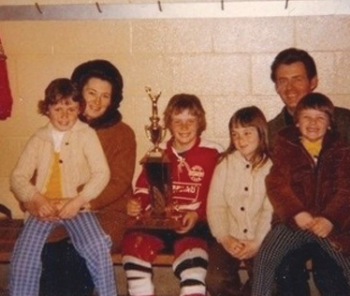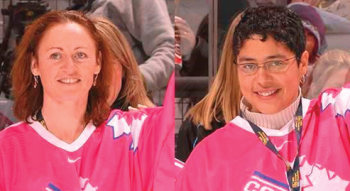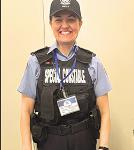
Emery’s glistening hockey jewel
By Tim Lambrinos
There may come a time when athletic skills evolve sufficiently so that women may become conventional participants in some of men’s professional sports’ competitions. Will there ever be a day when top professional teams all have mixed competitors as the norm? Perhaps the scenarios in mixed-doubles tennis or in recreational baseball games become routine?
Currently, the immensely successful Canadian Women’s Hockey team plays exhibition games against 15 to 17-year-old boys, and with mixed results.
Some of these female competitors become recognized internationally because they are special. No different than women that are recognized for their individual accomplishments in track and field or other pursuits. They may not be identical in terms of their skill-set and their level of play, but they continue to be special because they’ve been recognized for reaching a worldwide goal.
Within the sport of women’s ice hockey Geraldine Heaney is already recognized as one of the greatest sports legends to have originated from the Emery community. She has served Canada well when representing her nation on many occasions over many years. She has been a member of seven World Championship gold medal teams and has an Olympic gold and silver medal too. In 2011, she became one of four women to be inducted into the Hockey Hall of Fame.
Heaney grew up, along with her two brothers and two sisters, in a single family home on Yorkdale Crescent near Weston Road and Wilson. While on Yorkdale, she actually began her street hockey career playing with neighbourhood boys and was placed in net. She felt at the time that this was fine since all she really wanted was just to be part of the game, being in net or otherwise.
In 1972, she enrolled in kindergarten at Melody Road Public School on Strathburn Boulevard in Humberlea. In 1979, she began attending Emery Junior High School on Weston Road near Finch.
After this, she attended Emery Collegiate Institute and became a valuable member of the girls’ field hockey, soccer, badminton, volleyball and basketball teams. And a number of those teams eventually played in the Ontario Federation of School Athletic Association (OFSAA) provincial championships.
Heaney would frequent Habitant Arena on Weston Road and watch hockey games with different age groups and competitors. She studied every play and every strategy exhibited by the players on the ice.
In 1980, she found a girls’ league that she could participate in. It was the Toronto Aeros hockey team that played their games at a rink in Don Mills.

She convinced her father to allow her to join the team and remained loyal to it for the next 18 years – playing in nearly 2,000 games for the Aeros. The organization was one of the first structured groups to really take women’s hockey seriously and help grow the sport in Canada.
In 1986, Heaney enrolled at Seneca College and immediately became aware that the school had a women’s hockey team. She knew one thing. That she wanted to play on the team called, The Sting.
Once she became a member she would prove to be one of their outstanding players on the ice.
In 1990, the IIHF World Championships finally recognized women’s ice hockey as a category. This was credited to the efforts of Fran Rider, who was one of the founders of the Ontario Women’s Hockey Association.
The world championships were held in March of that year at the Civic Centre in Ottawa, Ontario. There was strong media and international attention drawn to the games. The gold medal game between Canada and the U.S. packed 9,000 people into the arena and there was over a million viewers watching at home and elsewhere on television.
Before the tournament, the Canadian Amateur Hockey Association decided that the Canadian women’s team would wear pink and white, instead of the traditional red and white. This one-time-only colour change experiment only lasted for this tournament since all Canadian teams are now required to wear red and white. However, this alteration in colour scheme was greeted with great enthusiasm at the time by the players and fans alike. The City of Ottawa was taken over by a “pink craze” during the entire tournament. Restaurants had pink-coloured foods on special and pink became the most popular colour ordered for flowers and bows across the nation. But there were a few critics that became offended by the unintended suggestion of selecting pink as the base colour for the women’s national team.
This Canadian women’s team would go onto victory in the tournament. Heaney’s eventual winning goal against Team U.S.A. sealed the gold medal victory for Canada. And she did it in perfect Bobby Orr fashion, flying through the air while the puck flew into the net. It has become one of the country’s greatest moments in sports’ history.
At the 1992 and 1994 Championships, she earned the Directorate Award for Best Defenceman. When women’s hockey debuted in the Olympics for the first time in 1998 at Nagano, Japan, Heaney was part of the silver medal winning team.
In 2002, she helped secure Canada’s double-gold when Team Canada ended a 50 year draught and finally captured the gold. She helped Team Canada win another gold medal again in the 2006 Winter Olympics in Turin, Italy.
The official line on her statistics with the Canadian national team reads, 27 goals and 66 assists in 125 games played. In 2011 she was inducted into the Hockey Hall of Fame.
These days, Heaney recently ended her six-year coaching stint at the University of Waterloo to help coach her own young daughter in hockey.

And she remains active working as an instructor for the PHL Academy that assists in the development of hockey programs for a number of hockey associations in the Hamilton area and across Ontario while teaching hockey and power skating to youth. The Academy is sponsored by the mega-store, Pro Hockey Life.
Heaney does not particularly care whom she offends on the subject of potentially organizing mixed sports with boys and girls. When she was asked by Melissa Isaacson of ESPN Sports whether girls should be playing on boys’ teams, she replied, “I think that it’s just parents thinking their girl is better than everyone else, that girls’ hockey is not good enough, and that’s just not the case. But some parents need to be educated. It’s great to see how many girls are playing hockey, but not parents who think their boys are all going to the NHL and their girls all going to the Olympics. I just shake my head because they just don’t get it and I’m being very honest. They don’t like what I have to say but I tell them, ‘You’re kidding yourselves’.”

Heaney indeed has crossed over many barriers and boundaries as a result of her physical pursuits, outspoken views and incredible athletic accomplishments.
She has been able to strive to achieve exceptional goals that only a few have ever been able to reach. Now as a member of the Hockey Hall of Fame, Geraldine Heaney will forever remain as another one of Emery’s authentic examples of a strong, resilient and true pioneer within Canadian sport.














